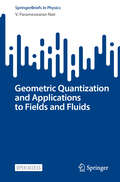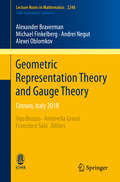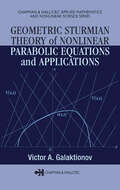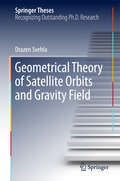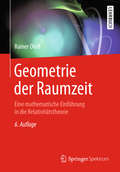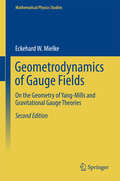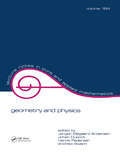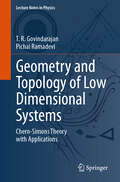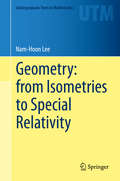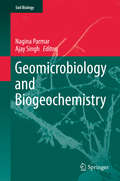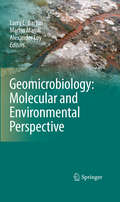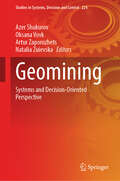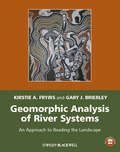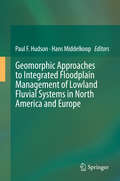- Table View
- List View
Geometric Quantization and Applications to Fields and Fluids (SpringerBriefs in Physics)
by V. Parameswaran NairThis open access book explains geometric quantization from a physicist’s perspective. After presenting the general formalism, it delves into several examples reflecting current research interests in high-energy physics and condensed matter physics. Applications explore Chern-Simons theory, theta vacuum, the Hall effect, fluid dynamics, and elements of noncommutative geometry. The content is tailored to appeal to researchers, graduate students, and advanced undergraduates in high-energy physics, particle physics, and mathematical physics. A background in differential geometry and group theory is beneficial for a comprehensive understanding of the discussions.
Geometric Representation Theory and Gauge Theory: Cetraro, Italy 2018 (Lecture Notes in Mathematics #2248)
by Alexander Braverman Michael Finkelberg Andrei Negut Alexei OblomkovThis book offers a review of the vibrant areas of geometric representation theory and gauge theory, which are characterized by a merging of traditional techniques in representation theory with the use of powerful tools from algebraic geometry, and with strong inputs from physics. The notes are based on lectures delivered at the CIME school "Geometric Representation Theory and Gauge Theory" held in Cetraro, Italy, in June 2018. They comprise three contributions, due to Alexander Braverman and Michael Finkelberg, Andrei Negut, and Alexei Oblomkov, respectively. Braverman and Finkelberg’s notes review the mathematical theory of the Coulomb branch of 3D N=4 quantum gauge theories. The purpose of Negut’s notes is to study moduli spaces of sheaves on a surface, as well as Hecke correspondences between them. Oblomkov's notes concern matrix factorizations and knot homology. This book will appeal to both mathematicians and theoretical physicists and will be a source of inspiration for PhD students and researchers.
Geometric Sturmian Theory of Nonlinear Parabolic Equations and Applications (Chapman & Hall/CRC Applied Mathematics & Nonlinear Science)
by Victor A. GalaktionovUnlike the classical Sturm theorems on the zeros of solutions of second-order ODEs, Sturm's evolution zero set analysis for parabolic PDEs did not attract much attention in the 19th century, and, in fact, it was lost or forgotten for almost a century. Briefly revived by P�lya in the 1930's and rediscovered in part several times since, it was not un
Geometrical Formulation of Renormalization-Group Method as an Asymptotic Analysis: With Applications to Derivation of Causal Fluid Dynamics (Fundamental Theories of Physics #206)
by Teiji Kunihiro Yuta Kikuchi Kyosuke TsumuraThis book presents a comprehensive account of the renormalization-group (RG) method and its extension, the doublet scheme, in a geometrical point of view. It extract long timescale macroscopic/mesoscopic dynamics from microscopic equations in an intuitively understandable way rather than in a mathematically rigorous manner and introduces readers to a mathematically elementary, but useful and widely applicable technique for analyzing asymptotic solutions in mathematical models of nature. The book begins with the basic notion of the RG theory, including its connection with the separation of scales. Then it formulates the RG method as a construction method of envelopes of the naive perturbative solutions containing secular terms, and then demonstrates the formulation in various types of evolution equations. Lastly, it describes successful physical examples, such as stochastic and transport phenomena including second-order relativistic as well as nonrelativistic fluid dynamics with causality and transport phenomena in cold atoms, with extensive numerical expositions of transport coefficients and relaxation times. Requiring only an undergraduate-level understanding of physics and mathematics, the book clearly describes the notions and mathematical techniques with a wealth of examples. It is a unique and can be enlightening resource for readers who feel mystified by renormalization theory in quantum field theory.
Geometrical Theory of Satellite Orbits and Gravity Field (Springer Theses)
by Drazen SvehlaThis book on space geodesy presents pioneering geometrical approaches in the modelling of satellite orbits and gravity field of the Earth, based on the gravity field missions CHAMP, GRACE and GOCE in the LEO orbit. Geometrical approach is also extended to precise positioning in space using multi-GNSS constellations and space geodesy techniques in the realization of the terrestrial and celestial reference frame of the Earth. This book addresses major new developments that were taking place in space geodesy in the last decade, namely the availability of GPS receivers onboard LEO satellites, the multitude of the new GNSS satellite navigation systems, the huge improvement in the accuracy of satellite clocks and the revolution in the determination of the Earth's gravity field with dedicated satellite missions.
Geometrical Vectors (Chicago Lectures in Physics)
by Gabriel WeinreichEvery advanced undergraduate and graduate student of physics must master the concepts of vectors and vector analysis. Yet most books cover this topic by merely repeating the introductory-level treatment based on a limited algebraic or analytic view of the subject.Geometrical Vectors introduces a more sophisticated approach, which not only brings together many loose ends of the traditional treatment, but also leads directly into the practical use of vectors in general curvilinear coordinates by carefully separating those relationships which are topologically invariant from those which are not. Based on the essentially geometric nature of the subject, this approach builds consistently on students' prior knowledge and geometrical intuition. Written in an informal and personal style, Geometrical Vectors provides a handy guide for any student of vector analysis. Clear, carefully constructed line drawings illustrate key points in the text, and problem sets as well as physical examples are provided.
Geometrical methods of mathematical physics
by Bernard F. SchutzIn recent years the methods of modern differential geometry have become of considerable importance in theoretical physics and have found application in relativity and cosmology, high-energy physics and field theory, thermodynamics, fluid dynamics and mechanics. This textbook provides an introduction to these methods - in particular Lie derivatives, Lie groups and differential forms - and covers their extensive applications to theoretical physics. The reader is assumed to have some familiarity with advanced calculus, linear algebra and a little elementary operator theory. The advanced physics undergraduate should therefore find the presentation quite accessible. This account will prove valuable for those with backgrounds in physics and applied mathematics who desire an introduction to the subject. Having studied the book, the reader will be able to comprehend research papers that use this mathematics and follow more advanced pure-mathematical expositions.
Geometrie der Raumzeit: Eine mathematische Einführung in die Relativitätstheorie
by Rainer OloffDie Relativitätstheorie ist in ihren Kernaussagen nicht mehr umstritten, gilt aber noch immer als kompliziert und nur schwer verstehbar. Das liegt unter anderem an dem aufwendigen mathematischen Apparat, der schon zur Formulierung ihrer Ergebnisse und erst recht zum Nachvollziehen der Argumentation notwendig ist. In diesem Lehrbuch werden die mathematischen Grundlagen der Relativitätstheorie systematisch entwickelt, das ist die Differentialgeometrie auf Mannigfaltigkeiten einschließlich Differentiation und Integration. Die Spezielle Relativitätstheorie wird als Tensorrechnung auf den Tangentialräumen dargestellt. Die zentrale Aussage der Allgemeinen Relativitätstheorie ist die Einstein'sche Feldgleichung, die die Krümmung zur Materie in Beziehung setzt. Ausführlich werden die relativistischen Effekte im Sonnensystem einschließlich der Schwarzen Löcher behandelt. Dieser Text richtet sich an Studierende der Physik und der Mathematik und setzt nur Grundkenntnisse aus der klassischen Differential- und Integralrechnung und der Linearen Algebra voraus. Für die neue Auflage wurde das Buch durchgesehen und alle bekannt gewordenen Fehler korrigiert.
Geometrodynamics of Gauge Fields
by Eckehard W. MielkeThis monograph aims to provide a unified, geometrical foundation of gauge theories of elementary particle physics. The underlying geometrical structure is unfolded in a coordinate-free manner via the modern mathematical notions of fibre bundles and exterior forms. Topics such as the dynamics of Yang-Mills theories, instanton solutions and topological invariants are included. By transferring these concepts to local space-time symmetries, generalizations of Einstein's theory of gravity arise in a Riemann-Cartan space with curvature and torsion. It provides the framework in which the (broken) Poincar#65533; gauge theory, the Rainich geometrization of the Einstein-Maxwell system, and higher-dimensional, non-abelian Kaluza-Klein theories are developed. Since the discovery of the Higgs boson, concepts of spontaneous symmetry breaking in gravity have come again into focus, and, in this revised edition, these will be exposed in geometric terms. Quantizing gravity remains an open issue: formulating it as a de Sitter type gauge theory in the spirit of Yang-Mills, some new progress in its topological form is presented. After symmetry breaking, Einstein's standard general relativity with cosmological constant emerges as a classical background. The geometrical structure of BRST quantization with non-propagating topological ghosts is developed in some detail.
Geometrodynamics of Gauge Fields: On the Geometry of Yang-Mills and Gravitational Gauge Theories (Mathematical Physics Studies)
by Eckehard W. MielkeThis monograph aims to provide a unified, geometrical foundation of gauge theories of elementary particle physics. The underlying geometrical structure is unfolded in a coordinate-free manner via the modern mathematical notions of fibre bundles and exterior forms. Topics such as the dynamics of Yang-Mills theories, instanton solutions and topological invariants are included. By transferring these concepts to local space-time symmetries, generalizations of Einstein's theory of gravity arise in a Riemann-Cartan space with curvature and torsion. It provides the framework in which the (broken) Poincaré gauge theory, the Rainich geometrization of the Einstein-Maxwell system, and higher-dimensional, non-abelian Kaluza-Klein theories are developed. Since the discovery of the Higgs boson, concepts of spontaneous symmetry breaking in gravity have come again into focus, and, in this revised edition, these will be exposed in geometric terms. Quantizing gravity remains an open issue: formulating it as a de Sitter type gauge theory in the spirit of Yang-Mills, some new progress in its topological form is presented. After symmetry breaking, Einstein’s standard general relativity with cosmological constant emerges as a classical background. The geometrical structure of BRST quantization with non-propagating topological ghosts is developed in some detail.
Geometry and Physics
by Jørgen Ellegaard Andersen; Johan Dupont; Henrik Pedersen; Andrew Swann"Based on the proceedings of the Special Session on Geometry and Physics held over a six month period at the University of Aarhus, Denmark and on articles from the Summer school held at Odense University, Denmark. Offers new contributions on a host of topics that involve physics, geometry, and topology. Written by more than 50 leading international experts."
Geometry and Physics of Branes
by Ugo BruzzoBranes are solitonic configurations of a string theory that are represented by extended objects in a higher-dimensional space-time. They are essential for a comprehension of the non-perturbative aspects of string theory, in particular, in connection with string dualities. From the mathematical viewpoint, branes are related to several important theo
Geometry and Topology of Low Dimensional Systems: Chern-Simons Theory with Applications (Lecture Notes in Physics #1027)
by T. R. Govindarajan Pichai RamadeviThis book introduces the field of topology, a branch of mathematics that explores the properties of geometric space, with a focus on low-dimensional systems. The authors discuss applications in various areas of physics. The first chapters of the book cover the formal aspects of topology, including classes, homotopic groups, metric spaces, and Riemannian and pseudo-Riemannian geometry. These topics are essential for understanding the theoretical concepts and notations used in the next chapters of the book. The applications encompass defects in crystalline structures, space topology, spin statistics, Braid group, Chern-Simons field theory, and 3D gravity, among others. This self-contained book provides all the necessary additional material for both physics and mathematics students. The presentation is enriched with examples and exercises, making it accessible for readers to grasp the concepts with ease. The authors adopt a pedagogical approach, posing many unsolved questions in simple situations that can serve as challenging projects for students. Suitable for a one-semester postgraduate level course, this text is ideal for teaching purposes.
Geometry from Dynamics, Classical and Quantum
by Giuseppe Marmo José F. Cariñena Alberto Ibort Giuseppe MorandiThis book describes, by using elementary techniques, how some geometrical structures widely used today in many areas of physics, like symplectic, Poisson, Lagrangian, Hermitian, etc. , emerge from dynamics. It is assumed that what can be accessed in actual experiences when studying a given system is just its dynamical behavior that is described by using a family of variables ("observables" of the system). The book departs from the principle that ''dynamics is first'' and then tries to answer in what sense the sole dynamics determines the geometrical structures that have proved so useful to describe the dynamics in so many important instances. In this vein it is shown that most of the geometrical structures that are used in the standard presentations of classical dynamics (Jacobi, Poisson, symplectic, Hamiltonian, Lagrangian) are determined, though in general not uniquely, by the dynamics alone. The same program is accomplished for the geometrical structures relevant to describe quantum dynamics. Finally, it is shown that further properties that allow the explicit description of the dynamics of certain dynamical systems, like integrability and super integrability, are deeply related to the previous development and will be covered in the last part of the book. The mathematical framework used to present the previous program is kept to an elementary level throughout the text, indicating where more advanced notions will be needed to proceed further. A family of relevant examples is discussed at length and the necessary ideas from geometry are elaborated along the text. However no effort is made to present an ''all-inclusive'' introduction to differential geometry as many other books already exist on the market doing exactly that However, the development of the previous program, considered as the posing and solution of a generalized inverse problem for geometry, leads to new ways of thinking and relating some of the most conspicuous geometrical structures appearing in Mathematical and Theoretical Physics.
Geometry of Minkowski Space-Time
by Dino Boccaletti Paolo Zampetti Vincenzo Catoni Roberto Cannata Francesco CatoniThis book provides an original introduction to the geometry of Minkowski space-time. A hundred years after the space-time formulation of special relativity by Hermann Minkowski, it is shown that the kinematical consequences of special relativity are merely a manifestation of space-time geometry. The book is written with the intention of providing students (and teachers) of the first years of University courses with a tool which is easy to be applied and allows the solution of any problem of relativistic kinematics at the same time. The book treats in a rigorous way, but using a non-sophisticated mathematics, the Kinematics of Special Relativity. As an example, the famous "Twin Paradox" is completely solved for all kinds of motions. The novelty of the presentation in this book consists in the extensive use of hyperbolic numbers, the simplest extension of complex numbers, for a complete formalization of the kinematics in the Minkowski space-time. Moreover, from this formalization the understanding of gravity comes as a manifestation of curvature of space-time, suggesting new research fields.
Geometry, Symmetries, and Classical Physics: A Mosaic
by Manousos MarkoutsakisThis book provides advanced undergraduate physics and mathematics students with an accessible yet detailed understanding of the fundamentals of differential geometry and symmetries in classical physics. Readers, working through the book, will obtain a thorough understanding of symmetry principles and their application in mechanics, field theory, and general relativity, and in addition acquire the necessary calculational skills to tackle more sophisticated questions in theoretical physics. Most of the topics covered in this book have previously only been scattered across many different sources of literature, therefore this is the first book to coherently present this treatment of topics in one comprehensive volume. Key features: Contains a modern, streamlined presentation of classical topics, which are normally taught separately Includes several advanced topics, such as the Belinfante energy-momentum tensor, the Weyl-Schouten theorem, the derivation of Noether currents for diffeomorphisms, and the definition of conserved integrals in general relativity Focuses on the clear presentation of the mathematical notions and calculational technique
Geometry, Topology and Operator Algebras: Global Analysis, Invariants and Their Significance in Theoretical Physics (Mathematical Physics Studies)
by Alexander Cardona Andrés F. Reyes LegaThis book offers a comprehensive exploration of contemporary intersections between geometry, topology, and theoretical physics, emphasizing their mathematical foundations and applications. Originating from lectures presented by experts during two summer schools held in Villa de Leyva, Colombia, the book reflects the synergy between global analysis, operator algebras, and their role in modern physics. The chapters present state-of-the-art developments on a wide range of topics: the geometry and topology of foliations, affine manifolds, C*-algebras, and the pseudo-differential calculus of boundary value problems. These are enriched by applications to the theory of topological quantum matter. The book is suitable for graduate students and researchers, offering detailed introductions to advanced topics such as the longitudinal index theorem for foliations, the geometry of the Poincaré half-space in a C*-algebra, and mathematical frameworks for topological matter. With a balance of foundational material and novel insights, it serves as both a learning resource and a reference for advanced studies at the intersection of mathematics and physics.
Geometry, Topology and Physics
by Mikio NakaharaDifferential geometry and topology have become essential tools for many theoretical physicists. In particular, they are indispensable in theoretical studies of condensed matter physics, gravity, and particle physics. Geometry, Topology and Physics, Second Edition introduces the ideas and techniques of differential geometry and topology at a level suitable for postgraduate students and researchers in these fields.The second edition of this popular and established text incorporates a number of changes designed to meet the needs of the reader and reflect the development of the subject. The book features a considerably expanded first chapter, reviewing aspects of path integral quantization and gauge theories. Chapter 2 introduces the mathematical concepts of maps, vector spaces, and topology. The following chapters focus on more elaborate concepts in geometry and topology and discuss the application of these concepts to liquid crystals, superfluid helium, general relativity, and bosonic string theory. Later chapters unify geometry and topology, exploring fiber bundles, characteristic classes, and index theorems. New to this second edition is the proof of the index theorem in terms of supersymmetric quantum mechanics. The final two chapters are devoted to the most fascinating applications of geometry and topology in contemporary physics, namely the study of anomalies in gauge field theories and the analysis of Polakov's bosonic string theory from the geometrical point of view.Geometry, Topology and Physics, Second Edition is an ideal introduction to differential geometry and topology for postgraduate students and researchers in theoretical and mathematical physics.
Geometry: from Isometries to Special Relativity (Undergraduate Texts in Mathematics)
by Nam-Hoon LeeThis textbook offers a geometric perspective on special relativity, bridging Euclidean space, hyperbolic space, and Einstein’s spacetime in one accessible, self-contained volume. Using tools tailored to undergraduates, the author explores Euclidean and non-Euclidean geometries, gradually building from intuitive to abstract spaces. By the end, readers will have encountered a range of topics, from isometries to the Lorentz–Minkowski plane, building an understanding of how geometry can be used to model special relativity. Beginning with intuitive spaces, such as the Euclidean plane and the sphere, a structure theorem for isometries is introduced that serves as a foundation for increasingly sophisticated topics, such as the hyperbolic plane and the Lorentz–Minkowski plane. By gradually introducing tools throughout, the author offers readers an accessible pathway to visualizing increasingly abstract geometric concepts. Numerous exercises are also included with selected solutions provided. Geometry: from Isometries to Special Relativity offers a unique approach to non-Euclidean geometries, culminating in a mathematical model for special relativity. The focus on isometries offers undergraduates an accessible progression from the intuitive to abstract; instructors will appreciate the complete instructor solutions manual available online. A background in elementary calculus is assumed.
Geomicrobiology and Biogeochemistry
by Ajay Singh Nagina ParmarOver the past 4 billion years, microorganisms have contributed to shaping the earth and making it more habitable for higher forms of life. They are remarkable in their metabolic diversity and their ability to harvest energy from oxidation and reduction reactions. Research on these microbiological processes has led to the newly evolving fields of geomicrobiology and biogeochemistry, linking the geosphere and the biosphere. This volume of the Soil Biology series provides an overview of the biogeochemical processes and the microorganisms involved, with an emphasis on the industrial applications. Topics treated include aspects such as bioremediation of contaminated environments, biomining, biotechnological applications of extremophiles, subsurface petroleum microbiology, enhanced oil recovery using microbes and their products, metal extraction from soil, soil elemental cycling and plant nutrition.
Geomicrobiology: Molecular and Environmental Perspective
by Larry L. Barton Alexander Loy Martin MandlThis book is an interdisciplinary review of recent developments in topics including origin of life, microbial-mineral interactions, and microbial processes functioning in marine and terrestrial environments. A major component of this book addresses molecular techniques to evaluate microbial evolution and assess relationships of microbes in complex, natural communities. The function of microbial community members and their possible geological impact are evaluated from a perspective of (meta)genomics, (meta)proteomics, and isotope labeling. As well as summarizing current knowledge in various areas, it also reveals unresolved questions that require future investigations. These chapters enhance our fundamental knowledge of geomicrobiology that contributes to the exploitation of microbial functions in mineral and environmental biotechnology applications. Authors have provided skillful reviews and outlined unique perspectives on environmental microorganisms and their related processes.
Geomicrobiology: Natural and Anthropogenic Settings
by Larry L. Barton Lucian C. StaicuThis volume brings together leading international experts to offer a unique and timely perspective on geomicrobiology through their latest research and findings. Chapters address interactions of marine and freshwater microorganisms contributing to geochemical cycles, including biochemical mechanisms for mineralization and transformation of solid minerals and dissolved metals. In addition, the resilience and physiological elasticity of specific bacteria in extreme environments is discussed, such as mechanisms of metal homeostasis and electrochemistry involving extracellular electron flow. Further coverage includes resource recovery (metals, minerals) using microbial-driven processes and technologies, with the aim to contribute to a better understanding of microbial potential within the framework of circular economy. This book is designed for professionals and students, including environmental engineers, microbiologists, and individuals studying the interaction of bacteria with metals and minerals in the environment. It is also a resource for students in academic programs or short courses focused on bacterial diversity in the environment, systems of bacterial energetics, resource recovery, and bacterial activities in extreme or nutrient-stressed environments. .
Geomining: Systems and Decision-Oriented Perspective (Studies in Systems, Decision and Control #224)
by Artur Zaporozhets Azer Shukurov Oksana Vovk Natalia ZuievskaThis book represents a comprehensive exploration of the intricate intersection between geology and mining through the lens of system-oriented perspectives. Geomining stands at the forefront of modern resource extraction, blending the principles of geology, engineering, transport, and environmental science to optimize the extraction of minerals and other valuable resources from the Earth's crust. It is a dynamic field that continually evolves in response to technological advancements, environmental concerns, and economic realities. In this book, we aim to capture the essence of geomining as a holistic system, emphasizing the interconnectedness of its various components and the importance of integrated approaches to resource management. The geomining is a complex of heavy industry sectors that includes the exploration of mineral deposits, the extraction of minerals from the Earth's subsurface, and the enrichment of valuable minerals. Among the main groups of the geomining industry, the following are distinguished—fuel extraction (coal, oil, shale, peat, natural gas extraction); ore mining (iron ore, manganese ore, extraction of non-ferrous ores, precious and rare metals, etc.); mining and chemical industry (extraction of potassium salts, rock salt, apatites, nephelines, bauxites, sulfur, phosphorites, etc.); extraction of mineral raw materials for the construction industry; extraction of mineral raw materials for refractory and ceramic industries; hydromeliorative activities. The concept of a system-oriented view on geomining recognizes that mining activities do not occur in isolation but are part of larger, interconnected systems that encompass geological, environmental, social, and economic dimensions. By adopting a systems perspective, we can better understand the complexities inherent in resource extraction and develop more sustainable and efficient mining practices. This book is divided into 3 parts, each focusing on different aspects of geomining from a systems perspective.
Geomorphic Analysis of River Systems
by Gary J. Brierley Kirstie A. FryirsFilling a niche in the geomorphology teaching market, this introductory book is built around a 12 week course in fluvial geomorphology.'Reading the landscape' entails making sense of what a riverscape looks like, how it works, how it has evolved over time, and how alterations to one part of a catchment may have secondary consequences elsewhere, over different timeframes. These place-based field analyses are framed within their topographic, climatic and environmental context. Issues and principles presented in the first part of this book provide foundational understandings that underpin the approach to reading the landscape that is presented in the second half of the book. In reading the landscape, detective-style investigations and interpretations are tied to theoretical and conceptual principles to generate catchment-specific analyses of river character, behaviour and evolution, including responses to human disturbance. This book has been constructed as an introductory text on river landscapes, providing a bridge and/or companion to quantitatively-framed or modelled approaches to landscape analysis that are addressed elsewhere. Key principles outlined in the book emphasise the importance of complexity, contingency and emergence in interpreting the character, behaviour and evolution of any given system.The target audience is second and third year undergraduate students in geomorphology, hydrology, earth science and environmental science, as well as river practitioners who use geomorphic understandings to guide scientific and/or management applications.The primary focus of Kirstie and Gary's research and teaching entails the use of geomorphic principles as a tool with which to develop coherent scientific understandings of river systems, and the application of these understandings in management practice. Kirstie and Gary are co-developers of the River Styles® Framework and Short Course that is widely used in river management, decision-making and training.Additional resources for this book can be found at: www.wiley.com/go/fryirs/riversystems.
Geomorphic Approaches to Integrated Floodplain Management of Lowland Fluvial Systems in North America and Europe
by Paul F. Hudson Hans MiddelkoopThis volume provides a comprehensive perspective on geomorphic approaches to management of lowland alluvial rivers in North America and Europe. Many lowland rivers have been heavily managed for flood control and navigation for decades or centuries, resulting in engineered channels and embanked floodplains with substantially altered sediment loads and geomorphic processes. Over the past decade, floodplain management of many lowland rivers has taken on new importance because of concerns about the potential for global environmental change to alter floodplain processes, necessitating revised management strategies that minimize flood risk while enhancing environmental attributes of floodplains influenced by local embankments and upstream dams. Recognition of the failure of old perspectives on river management and the need to enhance environmental sustainability has stimulated a new approach to river management. The manner that river restoration and integrated management are implemented, however, requires a case study approach that takes into account the impact of historic human impacts to the system, especially engineering. The river basins examined in this volume provide a representative coverage of the drainage of North America and Europe, taking into account a range of climatic and physiographic provinces. They include the 1) Sacramento (California, USA), 2) San Joaquin (California), 3) Missouri (Missouri, USA), 4) Red (Manitoba, Canada and Minnesota, USA), 5) Mississippi (Louisiana, USA), 6) Kissimmee (Florida, USA), 7) Ebro (Spain), 8) Rhone (France), 9) Rhine (Netherlands), 10) Danube (Romania), and 11) Volga (Russian Federation) Rivers. The case studies covered in these chapters span a range of fluvial modes of adjustment, including sediment, channel, hydrologic regime, floodplains, as well as ecosystem and environmental associations.
